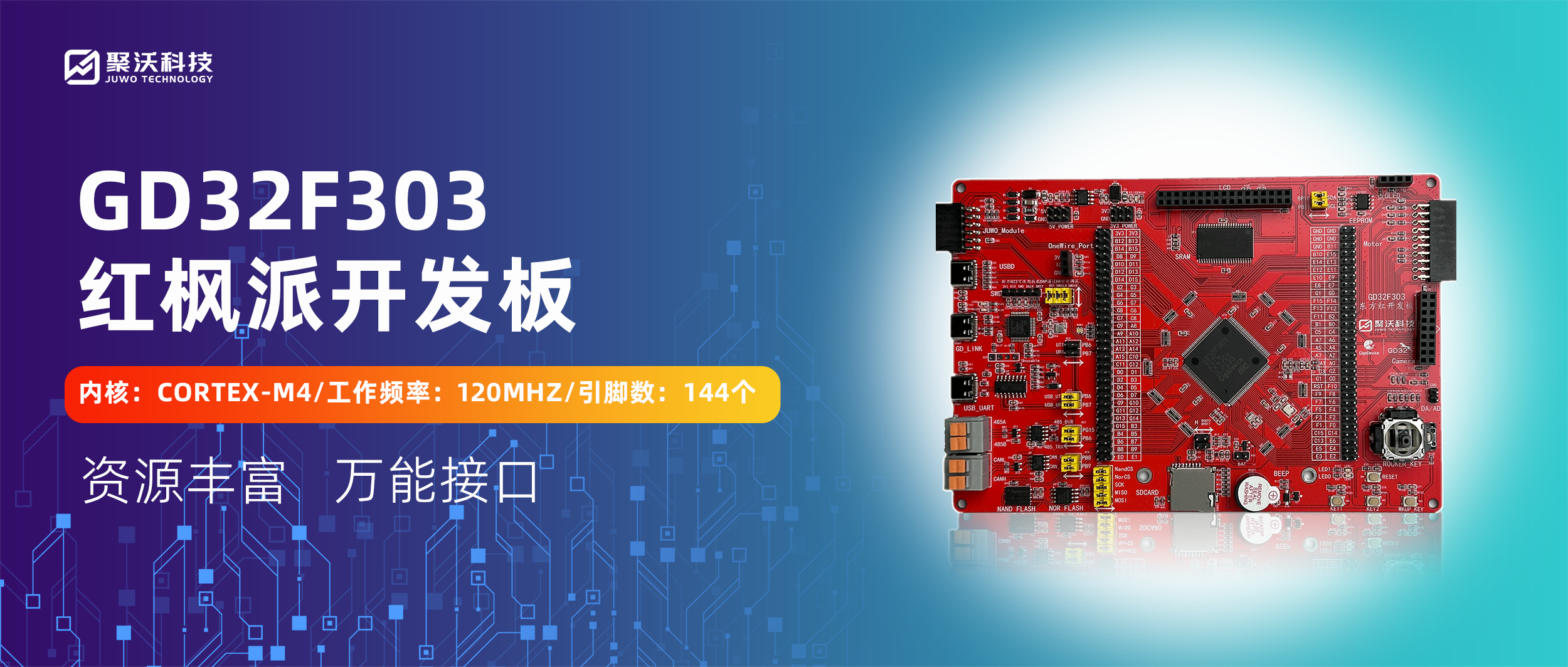

【GD32F303红枫派开发板使用手册】第十六讲 USART-DMA串口收发实验
描述

16.1 实验内容
通过本实验主要学习以下内容:
- 串口DMA工作原理
- 使用DMA进行串口收发
16.2 实验原理
16.2.1 串口DMA工作原理
在前面ADC章节中,我们介绍了DMA的工作原理,这里就不多做介绍。从GD32F303用户手册中可以查到,各串口的TX和RX分别对应DMA的不同通道,比如USART0的TX对应DMA0的通道3,而RX对应DMA0的通道4。
当需要使用DMA发送时,需要配置DMA工作为内存到外设的模式,DMA目标地址需要设置为串口的数据寄存器,当DMA使能后,一旦串口的TBE(发送空)标志位为1,则DMA自动从内存中搬运数据到串口数据寄存器中。
当需要使用DMA接受时,需要配置DMA工作为外设到内存的模式,DMA的源地址需要设置为串口的数据寄存器,当DMA使能,一旦串口收到一个字节数据,RBNE(接受非空)标志位为1,则DMA自动将数据寄存器中的数据搬运到内存中。
16.2.2 串口寄存器介绍
串口有几个非常重要的寄存器需要读者理解,这里单独用一个章节来介绍。
数据寄存器(USART_DATA)

该寄存器虽然只有一个,但内部是映射为发送和接受两个寄存器。
发送时,除了发送数据寄存器,还有一个移位寄存器,当数据写入数据寄存器中,移位寄存器空闲的情况下,数据从数据寄存器中转移到移位寄存器,移位寄存器按照低bit——高bit的顺序将数据移位到IO口上。
接收时,接收到的数据保存在数据寄存器中,CPU或DMA可以从该寄存器中读接收到的数据。
状态寄存器0(USART_STAT0 )

我们需要特别理解TBE、TC、RBNE、IDLE、OREE这几位。
- TBE(发送空):这个位置“1”表示现在可以往数据寄存器中写数据了,当移位寄存器空闲时,写入到数据寄存器中的数据则会转移到移位寄存器中,串口开始对外发送数据;
- TC(发送完成):发送数据时,当数据寄存器和移位寄存器都为空时,表示所有的数据都已经完成了,则TC置“1”,所以当连续发数据时,最后一个字节从移位寄存器中发送完,TC才会置起。
- RBNE(接受非空):当串口接受到一个字节数据,RBNE置“1”,此时CPU可以去数据寄存器中取数据,当使用了DMA接受,DMA自动将数据寄存器中数据搬走,当数据寄存器数据被读走/搬走,RBNE位自动清“0”;
- IDLE(空闲):该标志位用于检测接受空闲,当串口接受最后一个字节后,再往后一个字节时间内,没有接受到新的数据,则该位置“1”;
IDLE一般用于串口DMA接受中,DMA接受中,MCU无法知道发送方的数据个数,所以可以通过判断IDLE位(或IDLE中断)来判断发送方一帧数据发送结束了。 |
- OREE(溢出错误):当RBNE置位的情况,又接收到一个字节数据,则OREE位置“1”。
16.3 硬件设计
本实验使用DMA进行串口发送和接收,仍然使用USB转UART接口,硬件设计见上一章。
16.4 代码解析
16.4.1 串口DMA发送函数
在driver_uart.c中定义了串口DMA发送函数driver_uart_dma_transmit:
| C Drv_Err driver_uart_dma_transmit(typdef_uart_struct *uartx,uint8_t *pbuff,uint16_t length) { Drv_Err uart_state=DRV_ERROR; uint32_t timeout = driver_tick; while(uartx->uart_control.Com_Flag.Bits.SendState==1){ if((timeout+UART_TIMEOUT_MS) <= driver_tick) { uartx->uart_control.Com_Flag.Bits.SendState=0; return DRV_ERROR; } } uartx->uart_control.Com_Flag.Bits.SendSucess=0; uartx->uart_control.Com_Flag.Bits.SendState=1; uartx->uart_control.p_Send=pbuff; uartx->uart_control.SendSize=length; uartx->uart_control.SendCount=0; uart_state=driver_dma_flag_wait_timeout(uartx->uart_tx_dma,DMA_FLAG_FTF,SET); usart_dma_transmit_config(uartx->uart_x,USART_DENT_DISABLE); driver_dma_start(uartx->uart_tx_dma,pbuff,length); usart_flag_clear(uartx->uart_x,USART_FLAG_TC); usart_dma_transmit_config(uartx->uart_x,USART_DENT_ENABLE); usart_interrupt_enable(uartx->uart_x,USART_INT_TC); return uart_state; } |
16.4.2 串口DMA接收函数
在driver_uart.c中定义了串口DMA接收函数driver_uart_dma_receive:
| C Drv_Err driver_uart_dma_receive(typdef_uart_struct *uartx,uint8_t *pbuff,uint16_t length) { Drv_Err uart_state=DRV_SUCCESS; uint32_t timeout = driver_tick; while(uartx->uart_control.Com_Flag.Bits.RecState==1){ if((timeout+UART_TIMEOUT_MS) <= driver_tick) { uartx->uart_control.Com_Flag.Bits.RecState=0; return DRV_ERROR; } } uartx->uart_control.Com_Flag.Bits.RecSuccess=0; uartx->uart_control.Com_Flag.Bits.RecState=1; uartx->uart_control.p_Rec=pbuff; uartx->uart_control.RecSize=length; uartx->uart_control.RecCount=0; usart_dma_receive_config(uartx->uart_x,USART_DENR_DISABLE); driver_dma_start(uartx->uart_rx_dma,pbuff,length); USART_STAT0(uartx->uart_x); usart_data_receive(uartx->uart_x); usart_interrupt_flag_clear(uartx->uart_x,USART_INT_FLAG_IDLE); usart_interrupt_enable(uartx->uart_x,USART_INT_IDLE); usart_dma_receive_config(uartx->uart_x,USART_DENR_ENABLE); return uart_state; } |
16.4.3 main函数实现
以下为main函数代码:
| C int main(void) { delay_init(); //初始化UART为DMA模式,注册接受完成(IDLE)回调函数 BOARD_UART.uart_mode_tx=MODE_DMA; BOARD_UART.uart_mode_rx=MODE_DMA; BOARD_UART.uart_idle_callback=user_receive_complete_callback; bsp_uart_init(&BOARD_UART); nvic_irq_enable(USART0_IRQn,2,0); delay_ms(1000); printf("uart dma mode sends and receives loopback packets of indefinite length.\r\n"); //配置UART接受,最长100byte driver_uart_dma_receive(&BOARD_UART,uart_rec_buff,100); while (1) { //查询到接受完成回调函数标志 if(uart_receive_complete_flag==SET) { uart_receive_complete_flag=RESET; //发送刚接受到的数据 driver_uart_dma_transmit(&BOARD_UART,uart_send_buff,uart_receive_count); } } } |
本例程main函数首先进行了延时函数初始化,再初始化UART为DMA模式,接着配置串口BOARD_UART,开启串口中断NVIC,这里使用到了IDLE中断,用来接受不定长数据,然后配置串口DMA接受,最长100个字节,所以我们可以给串口发送100个字节以下长度的数据。在while(1)循环中循环查询uart_receive_complete_flag标志位,当该标志位为“SET”时,表示IDLE中断被触发,一帧数据接受完,最后将接收到的帧数据通过DMA发送方式原封不动发送到串口上。
16.4.4 中断函数
在bsp_uart.c中定义了串口中断处理函数
| C void USART0_IRQHandler(void) { driver_uart_int_handler(&BOARD_UART); } |
在driver_uart.c中定义了driver_uart_int_handler函数:
| C Drv_Err driver_uart_int_handler(typdef_uart_struct *uartx) { Drv_Err uart_state=DRV_SUCCESS; if(usart_interrupt_flag_get(uartx->uart_x,USART_INT_FLAG_RBNE)!=RESET) { if(uartx->uart_control.RecCount < uartx->uart_control.RecSize){ uartx->uart_control.p_Rec[uartx->uart_control.RecCount]=usart_data_receive(uartx->uart_x); uartx->uart_control.RecCount++; } else{ usart_data_receive(uartx->uart_x); uart_state=DRV_ERROR; //err 溢出 } if(uartx->uart_rbne_callback!=NULL){ uartx->uart_rbne_callback(uartx); } //callback if(uartx->uart_control.RecCount == uartx->uart_control.RecSize){ uartx->uart_control.Com_Flag.Bits.RecSuccess=1; uartx->uart_control.Com_Flag.Bits.RecState=0; uartx->uart_control.RecCount=0; } } if(usart_interrupt_flag_get(uartx->uart_x,USART_INT_FLAG_IDLE)!=RESET) { usart_interrupt_flag_clear(uartx->uart_x,USART_INT_FLAG_IDLE); USART_STAT0(uartx->uart_x); USART_DATA(uartx->uart_x); if( (uartx->uart_mode_rx==MODE_INT && uartx->uart_control.RecCount>0) \ ||(uartx->uart_mode_rx==MODE_DMA && dma_transfer_number_get(uartx->uart_rx_dma->dmax,uartx->uart_rx_dma->dma_chx)!=uartx->uart_control.RecSize)) { uartx->uart_control.Com_Flag.Bits.RecSuccess=1; uartx->uart_control.Com_Flag.Bits.RecState=0; if(uartx->uart_mode_rx==MODE_DMA){ uartx->uart_control.RecCount=uartx->uart_control.RecSize-dma_transfer_number_get(uartx->uart_rx_dma->dmax,uartx->uart_rx_dma->dma_chx); } //callback if(uartx->uart_idle_callback!=NULL){ uartx->uart_idle_callback(uartx); } } } if(usart_interrupt_flag_get(uartx->uart_x,USART_INT_FLAG_TBE)!=RESET) { usart_data_transmit(uartx->uart_x,uartx->uart_control.p_Send[uartx->uart_control.SendCount]); uartx->uart_control.SendCount++; if(uartx->uart_tbe_callback!=NULL){ uartx->uart_tbe_callback(uartx); } if(uartx->uart_control.SendCount >= uartx->uart_control.SendSize) { uartx->uart_control.SendCount=0; usart_interrupt_disable(uartx->uart_x, USART_INT_TBE); usart_interrupt_enable(uartx->uart_x, USART_INT_TC); } } if(usart_interrupt_flag_get(uartx->uart_x,USART_INT_FLAG_TC)!=RESET) { usart_interrupt_disable(uartx->uart_x, USART_INT_TC); usart_flag_clear(uartx->uart_x,USART_FLAG_TC); if( !(uartx->uart_mode_rx==MODE_DMA && dma_transfer_number_get(uartx->uart_tx_dma->dmax,uartx->uart_tx_dma->dma_chx)!=0) ) { uartx->uart_control.Com_Flag.Bits.SendSucess=1; uartx->uart_control.Com_Flag.Bits.SendState=0; if(uartx->uart_tc_callback!=NULL){ uartx->uart_tc_callback(uartx); } uartx->uart_control.SendCount=0; } } if(usart_flag_get(uartx->uart_x,USART_FLAG_ORERR)==SET) { usart_flag_clear(uartx->uart_x,USART_FLAG_ORERR); USART_STAT0(uartx->uart_x); USART_DATA(uartx->uart_x); uart_state=DRV_ERROR; } return uart_state; } |
16.5 实验结果
使用USB-TypeC线,连接电脑和板上USB to UART口后,使用串口调试助手发送一帧数据到MCU,MCU会将这帧数据回发到串口调试助手中。


本教程由GD32 MCU方案商聚沃科技原创发布,了解更多GD32 MCU教程,关注聚沃科技官网
-
GD32的串口DMA收发数据失败怎么解决?2025-09-17 211
-
【GD32F303红枫派开发板使用手册】第二十讲 SPI-SPI NAND FLASH读写实验2024-06-20 3075
-
【GD32F303红枫派开发板使用手册】第十七讲 USART-中断串口收发实验2024-06-17 2252
-
【GD32F303红枫派开发板使用手册】第五讲 FMC-片内Flash擦写读实验2024-06-02 2287
-
【GD32F303红枫派开发板使用手册】第三讲 GPIO-按键查询检测实验2024-05-30 1916
-
【GD32F303红枫派开发板使用手册】第二讲 GPIO-流水灯实验2024-05-29 4676
-
GD32F303固件库开发2023-07-27 2346
-
STM32CUBEMX开发GD32F303(8)----USART收发配置2022-11-29 4433
-
GD32F303开发板介绍2022-01-17 1752
-
星空派GD32F303开发板的相关资料下载2021-12-10 4033
-
【星空派GD32F303开发板试用体验】+板卡概览2021-11-06 3718
-
【星空派GD32F303开发板试用体验】开箱+环境搭建2021-10-18 3762
-
【GD32F303】星空派介绍2021-09-11 5308
全部0条评论

快来发表一下你的评论吧 !

